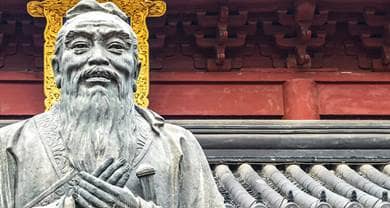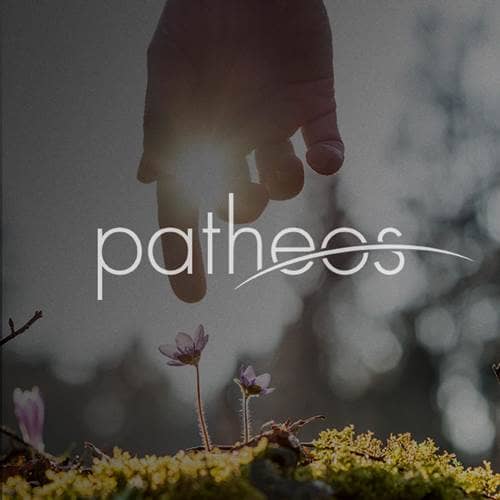- Trending:
- Forgiveness
- |
- Resurrection
- |
- Joy
- |
- Feminism
- |
- Afterlife

RELIGION LIBRARY
Confucianism
Sacred Texts
| The Analects by Confucius, Translated by James Legge (1893) |
| Section 1, Parts 1-6 Section 2, Parts 7-11 Section 3, Parts 12-15 Section 4, Parts 16-20 |
Kongzi himself left no writings. Collections of aphorisms and anecdotes related to Kongzi, such as the Lunyu ("Analects"), were assembled by Kongzi's disciples after his death. Neither the Lunyu nor other texts related to early Confucian thinkers were as important to Kongzi's followers as the Wujing ("Five Classics" of Western Zhou origin), which traditionally are attributed to Kongzi as writer or editor. It was these works of early Chinese literature that became the first canonical writings of the Confucian tradition in the 2nd century B.C.E., and it was not until the 12th century C.E. that texts directly concerned with Kongzi and other founders of the tradition attained primary scriptural status.
The Wujing did not attain their final form until Confucianism was adopted as the Han dynasty's official ideology and its most cherished texts became the basis of the civil service examination system that dominated official education in China for more than 2,000 years. They include the Yijing (Classic of Changes), the Shijing (Classic of Poetry), the Liji (Record of Rituals), the Shujing (Classic of Documents), and the Chunqiu (Spring and Autumn Annals). For early Confucians, the Yijing -- which originally was a manual of divination used by the Western Zhou court -- confirmed their view that human beings and the universe exist in a harmonious unity, which then allows events in one sphere (e.g., the natural world) to influence events in another sphere (e.g., human affairs), and thus allow for the prediction of such events. The Shijing was cherished for its many poetic depictions of unrequited love, which Confucians tended to interpret as allegories of the virtuous minister's longing for a sage ruler. The Liji describes court rituals and other ceremonies that Confucians sought to rediscover and reenact as a way of restoring society to its lapsed virtue. Both the Shujing and the Chunqiu were read by Confucians not only as records of past events, but also as precedents and models for the present and the future. All of these texts were based on Western Zhou writings, but all subsequently were edited and altered by Confucians, especially during the Han dynasty. From the Han dynasty until the Ming dynasty (1368-1644 C.E.), most candidates for government office in China were required to pass examinations based on their knowledge not only of the Wujing, but of the standard Confucian interpretations of these texts.
 Probably beginning around the time of Kongzi's death, sayings attributed to him and recollections of his life were collected by various generations of his disciples and their followers, eventually producing the Lunyu by sometime during the Han dynasty (although the greater part of the text no doubt is of much earlier origin). The Lunyu is a highly varied work that contains depictions of the life and teachings not only of Kongzi, but also of his foremost followers. Some of these depictions are at odds with others, as in the narratives about Kongzi and his beloved disciple Yan Hui. Some passages describe Yan Hui as first among Kongzi's students, while others downplay his status in the early Confucian community. Other examples of tensions in the text include how various passages describe Kongzi's primary concerns. Some passages emphasize his teaching about ritual, others his love of literature, others his views of Tian, and still others his ideas about government. Both the collection of so many different representations of Kongzi in one text and the subsequent canonical status of that text show that Confucians, like shapers of scripture in other traditions, have been able to harmonize these varying images of their master.
Probably beginning around the time of Kongzi's death, sayings attributed to him and recollections of his life were collected by various generations of his disciples and their followers, eventually producing the Lunyu by sometime during the Han dynasty (although the greater part of the text no doubt is of much earlier origin). The Lunyu is a highly varied work that contains depictions of the life and teachings not only of Kongzi, but also of his foremost followers. Some of these depictions are at odds with others, as in the narratives about Kongzi and his beloved disciple Yan Hui. Some passages describe Yan Hui as first among Kongzi's students, while others downplay his status in the early Confucian community. Other examples of tensions in the text include how various passages describe Kongzi's primary concerns. Some passages emphasize his teaching about ritual, others his love of literature, others his views of Tian, and still others his ideas about government. Both the collection of so many different representations of Kongzi in one text and the subsequent canonical status of that text show that Confucians, like shapers of scripture in other traditions, have been able to harmonize these varying images of their master.
 The process that produced the Lunyu was mirrored in the development of texts associated with Mengzi and Xunzi, as well as two other texts, the Zhongyong (The Doctrine of the Mean) and the Daxue (The Great Learning). The Zhongyong traditionally is attributed to Kongzi's grandson Zisi, who supposedly taught Mengzi, and is concerned with the proper relations between people in a hierarchical society modeled after early Confucians' idealized view of the Western Zhou dynasty. The Daxue traditionally is attributed to Kongzi's disciple Zengzi and is characterized by somewhat more mystical concerns than the Zhongyong, such as harmonizing oneself with the Tao by understanding its patterns both within and without oneself. [The Lunyu and Zhongyong were originally chapters in the Record of Rituals.]
The process that produced the Lunyu was mirrored in the development of texts associated with Mengzi and Xunzi, as well as two other texts, the Zhongyong (The Doctrine of the Mean) and the Daxue (The Great Learning). The Zhongyong traditionally is attributed to Kongzi's grandson Zisi, who supposedly taught Mengzi, and is concerned with the proper relations between people in a hierarchical society modeled after early Confucians' idealized view of the Western Zhou dynasty. The Daxue traditionally is attributed to Kongzi's disciple Zengzi and is characterized by somewhat more mystical concerns than the Zhongyong, such as harmonizing oneself with the Tao by understanding its patterns both within and without oneself. [The Lunyu and Zhongyong were originally chapters in the Record of Rituals.]










